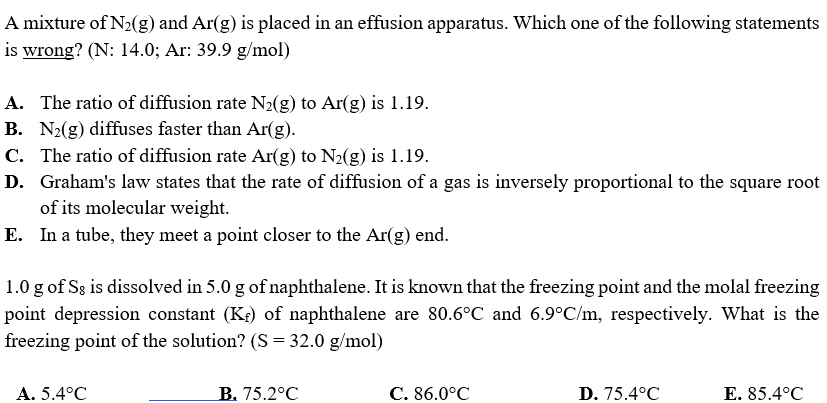A mixture of N2(g) and Ar(g) is placed in an effusion apparatus. Which one of the following statements is wrong? (N: 14.0; Ar: 39.9 g/mol) A. The ratio of diffusion rate N2(g) to Ar(g) is 1.19. B. N2(g) diffuses faster than Ar(g). C. The ratio of diffusion rate Ar(g) to N2(g) is 1.19. D. Graham's law states that the rate of diffusion of a gas is inversely proportional to the square root of its molecular weight. E. In a tube, they meet a point closer to the Ar(g) end.
A mixture of N2(g) and Ar(g) is placed in an effusion apparatus. Which one of the following statements is wrong? (N: 14.0; Ar: 39.9 g/mol) A. The ratio of diffusion rate N2(g) to Ar(g) is 1.19. B. N2(g) diffuses faster than Ar(g). C. The ratio of diffusion rate Ar(g) to N2(g) is 1.19. D. Graham's law states that the rate of diffusion of a gas is inversely proportional to the square root of its molecular weight. E. In a tube, they meet a point closer to the Ar(g) end.
Chemistry & Chemical Reactivity
10th Edition
ISBN:9781337399074
Author:John C. Kotz, Paul M. Treichel, John Townsend, David Treichel
Publisher:John C. Kotz, Paul M. Treichel, John Townsend, David Treichel
Chapter10: Gases And Their Properties
Section: Chapter Questions
Problem 81GQ
Related questions
Question
please help

Transcribed Image Text:A mixture of N2(g) and Ar(g) is placed in an effusion apparatus. Which one of the following statements
is wrong? (N: 14.0; Ar: 39.9 g/mol)
A. The ratio of diffusion rate N2(g) to Ar(g) is 1.19.
B. N2(g) diffuses faster than Ar(g).
C. The ratio of diffusion rate Ar(g) to N2(g) is 1.19.
D. Graham's law states that the rate of diffusion of a gas is inversely proportional to the square root
of its molecular weight.
E. In a tube, they meet a point closer to the Ar(g) end.
1.0 g of Sg is dissolved in 5.0 g of naphthalene. It is known that the freezing point and the molal freezing
point depression constant (K;) of naphthalene are 80.6°C and 6.9°C/m, respectively. What is the
freezing point of the solution? (S = 32.0 g/mol)
A. 5.4°C
B. 75.2°C
С. 86.0°C
D. 75.4°C
Е. 85.4°C
Expert Solution
This question has been solved!
Explore an expertly crafted, step-by-step solution for a thorough understanding of key concepts.
This is a popular solution!
Trending now
This is a popular solution!
Step by step
Solved in 2 steps

Knowledge Booster
Learn more about
Need a deep-dive on the concept behind this application? Look no further. Learn more about this topic, chemistry and related others by exploring similar questions and additional content below.Recommended textbooks for you

Chemistry & Chemical Reactivity
Chemistry
ISBN:
9781337399074
Author:
John C. Kotz, Paul M. Treichel, John Townsend, David Treichel
Publisher:
Cengage Learning

Chemistry & Chemical Reactivity
Chemistry
ISBN:
9781133949640
Author:
John C. Kotz, Paul M. Treichel, John Townsend, David Treichel
Publisher:
Cengage Learning

Chemistry: An Atoms First Approach
Chemistry
ISBN:
9781305079243
Author:
Steven S. Zumdahl, Susan A. Zumdahl
Publisher:
Cengage Learning

Chemistry & Chemical Reactivity
Chemistry
ISBN:
9781337399074
Author:
John C. Kotz, Paul M. Treichel, John Townsend, David Treichel
Publisher:
Cengage Learning

Chemistry & Chemical Reactivity
Chemistry
ISBN:
9781133949640
Author:
John C. Kotz, Paul M. Treichel, John Townsend, David Treichel
Publisher:
Cengage Learning

Chemistry: An Atoms First Approach
Chemistry
ISBN:
9781305079243
Author:
Steven S. Zumdahl, Susan A. Zumdahl
Publisher:
Cengage Learning


Chemistry: Principles and Reactions
Chemistry
ISBN:
9781305079373
Author:
William L. Masterton, Cecile N. Hurley
Publisher:
Cengage Learning

Introductory Chemistry: A Foundation
Chemistry
ISBN:
9781337399425
Author:
Steven S. Zumdahl, Donald J. DeCoste
Publisher:
Cengage Learning